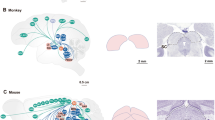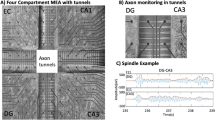Summary
-
1.
A pair of identifiable symmetrically placed neurons (CeW) in the cerebral ganglion of the nudibranch mollusk,Tritonia diomedea, exerts strong direct control over the generation of the rhythmic escape-swimming motor pattern.
-
2.
In intact animal preparations, the CeW neurons produced action potential bursts immediately preceding each flexion cycle (Fig. 1).
-
3.
Direct brief stimulation of a single CeW neuron elicited one or more complete flexion cycles. Responses of more than one flexion cycle corresponded to recurrent bursting activity in the stimulated CeW neuron. In addition, the response included aspects of the preparation to swim and its proper termination (Figs. 2, 3).
-
4.
Inhibition of both CeW neurons to prevent the firing of action potentials prior to stimulation of the swimming behavior prevented the generation of the motor pattern directing swimming and termination but not preparation (Fig. 4).
-
5.
The great majority of interactions between CeW's and other central neurons appeared polysynaptic, including a long-lasting inhibition exerted by the CeW's over many neurons not obviously involved in the swimming pattern (Fig. 6).
-
6.
A depolarizing excitation plateau was seen in CeW neurons during their bursting activity which has the same time course as that seen in motoneurons. In one instance, direct stimulation of a dorsal flexor motoneuron reliably elicited epsp volleys in a contralateral CeW with a one-second latency. No ventral flexor motoneurons elicited a similar regenerative response.
-
7.
The CeW neurons function at a dominant controlling level in what may be an interneuronal pattern generator. They may act to inhibit certain competing behaviors as well.
Similar content being viewed by others
References
Davis, W.J., Mpitsos, G.J., Pinneo, J.M.: The behavioral hierarchy of the molluskPleurobranchaea. I. The dominant position of the feeding behavior. J. comp. Physiol.90, 207–224 (1974)
Davis, W.J., Seigler, M.V.S., Mpitsos, G. J.: Distributed neuronal oscillators and efference copy in the feeding system ofPleurobranchaea. J. Neurophysiol.36, 258–274 (1973)
Dorsett, D.A., Willows, A.O.D., Hoyle, G.: Neuronal basis of behavior inTritonia. IV. Central origin of a fixed action pattern. J. Neurobiol.4, 287–300 (1973)
Friesen, O.W., Poon, M., Stent, G.S.: An oscillatory neuronal circuit generating a locomotory rhythm. Proc. nat. Acad. Sci.73, 3734–3738 (1976)
Getting, P.A.:Tritonia swimming: Triggering of a fixed action pattern. Brain Res.96, 128–133 (1975)
Getting, P.A.: Afferent neurons mediating escape-swimming of the marine mollusk,Tritonia diomedea. J. comp. Physiol.110, 271–386 (1976)
Getting, P.A.: Neuronal organization of escape swimming inTritonia. J. comp. Physiol.121, 325–342 (1977)
Gillette, R., Davis, W.J.: Command neurons for feeding behavior in the molluskPleurobranchaea. Int. Cong. Physiol. Sci., XXVII, 1977
Grillner, S.: Locomotion in vertebrates: central mechanisms and reflex interactions. Physiol. Rev.55, 304–347 (1975)
Kater, S.B.: Feeding inHelisoma trivolvis: the morphological and physiological bases of a fixed action pattern. Amer. Zool.14, 1017–1036 (1974)
Kennedy, D.: Neural elements in relation to neural function. In: Simpler networks and behavior (ed. J.C. Fentress), pp. 65–81. Sunderland: Sinauer Assoc. Inc. 1976
Kristan, W.B., Stent, G.S., Ort, CA.: Neuronal control of swimming in the medicinal leech. III. Impulse patterns in the motoneurons. J. comp. Physiol.94, 155–176 (1974)
Maynard, D.M.: Simpler networks. Ann. N.Y. Acad. Sci.193, 59–72 (1972)
Mendelson, M.: Oscillator neurons in crustacean ganglia. Science171, 1170–1173 (1970)
Moffett, S.: Neuronal events underlying rhythmic behavior in invertebrates. Comp. Biochem. Physiol.57A, 187–195 (1977)
Mulloney, B., Selverston, A.I.: Organization of the stomatogastric system of the spiny lobster. III. Coordination of the two subsets of the gastric system. J. comp. Physiol.91, 53–78 (1974)
Selverston, A.I.: Structural and functional bases of motor pattern generation in the stomatogastric ganglion of the lobster. Amer. Zool.14, 957–972 (1974)
Selverston, A.I.: A model system for the study of rhythmic behavior. In: Simpler networks and behavior (ed. J.C. Fentress), pp. 82–98. Sunderland: Sinauer Assoc. Inc. 1976
Willows, A.O.D.: Trigger Neurons in the mollusk,Tritonia. In: Neural control of locomotion (eds. R.M. Herman, S. Grillner, P.S. Stein, D.G. Stuart) pp. 327–349. New York: Plenum Publ. Corp. 1976
Willows, A.O.D.: The physiology of feeding inTritonia. I. Behavior mechanics. J. Mar. Behav. Physiol., in press
Willows, A.O.D., Dorsett, D.A., Hoyle, G.: The neuronal basis of behavior inTritonia. I. Functional organization of the nervous system. J. Neurobiol.4, 207–237 (1973a)
Willows, A.O.D., Dorsett, D.A., Hoyle, G.: The neuronal basis of behavior inTritonia. III. Neuronal mechanism of a fixed action pattern. J. Neurobiol.4, 255–285 (1973b)
Wilson, D.M.: The central nervous control of flight in a locust. J. exp. Biol.38, 471–490 (1961)
Author information
Authors and Affiliations
Additional information
We would like to thank R.W. Snow, T.J. Thompson and especially P.E. Lloyd for considerable assistance during the course of these experiments. Drs. J.W. Truman, J. Palka and K. Graubard provided a critical reading of the manuscript. This work was supported by NSF grant #BMS 75-13597 to A.O.D. Willows and an NSF Pre-Doctoral Fellowship to P.H. Taghert.
Rights and permissions
About this article
Cite this article
Taghert, P.H., Willows, A.O.D. Control of a fixed action pattern by single, central neurons in the marine mollusk,Tritonia diomedea . J. Comp. Physiol. 123, 253–259 (1978). https://doi.org/10.1007/BF00656878
Accepted:
Issue Date:
DOI: https://doi.org/10.1007/BF00656878




